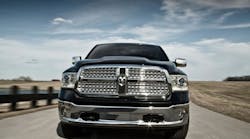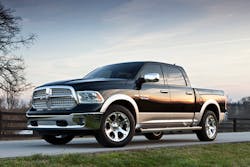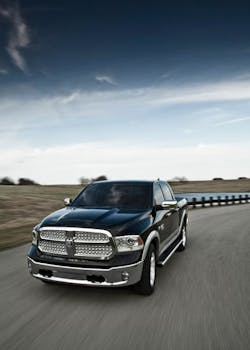It’s no secret that better fuel economy is being demanded across all classes of trucks these days – and not just because of government mandates, either.
Take pickup trucks, for example. Performance has long trumped fuel economy for folks using these ubiquitous vehicles in any number of work applications, in both diesel and gasoline configurations, simply because if the truck couldn’t adequately haul it, carry it, or tow it, then it failed in its duty as work tool.Yet when the cost of fuel is up near $4 per gallon for gasoline and over that mark for diesel, these tools become incredibly expensive to operate. Thus OEMs are trying to package together the best of what have been disparate worlds in the past – performance and fuel economy – without compromising either too much.
Ford Motor Co. achieved this with the twin-turbocharged V6 EcoBoost engine a couple of years ago for its F-150 pickup, getting fuel economy up into the 20 mpg range while still providing plenty of power (two turbochargers!) for performance.
Now Chrysler’s Ram Truck division is taking a crack at this with the re-designed 2013 Ram 1500 pickup, offering a 3.6-liter Pentastar V-6 engine that offers 42% more horsepower and 13% more torque yet at least 20% better fuel economy when compared to its previous 3.7-liter V-6 powertrain.
The same equation is happening on the V8 side of the pickup ledger as well, with Ram’s new 5.7-liter HEMI V-8 with “Fuel Saver Technology” (more on that in a bit) and variable-valve timing offering 395 horsepower and 407 lb.-ft. of torque yet at least 10% better fuel economy when compared to Ram’s 2012 V-8 powertrain package.
[Fred Diaz, president and CEO of the Ram Truck division and Chrysler de Mexico, discussed those features and more during the unveiling of the 2013 Ram 1500 this week at the New York Auto show, which you can watch below.]
OK, so how is Ram doing this: packaging fuel economy and performance together with minimal compromises?
First, the OEM is using a new eight-speed automatic transmission called the TorqueFlite 8, which is standard equipment on 1500 models equipped with the 3.6-liter V-6. That doubles the amount of gears compared to previously available four-speed automatic transmission, which helps vastly improve fuel economy, according to Ram’s engineering team.
Then there are the “little things” that provide incremental gains in fuel efficiency that, when put together, add up to some big savings.
For example, there’s a new thermal management system designed to quickly raise engine and transmission fluid temperatures. By raising fluid temperatures, parasitic losses resulting from high-viscosity engine oil and transmission fluid can be reduced, improving fuel efficiency by 1.7%, according to Ram.
Here’s how it works: As the engine temperature increases to pre-determined levels, warm engine coolant is circulated through a thermal exchange unit, which also contains dedicated pathways for transmission fluid. As the thermal exchange unit heats up, it also heats up the transmission fluid. This action dramatically reduces warm up time for the transmission, improving fuel economy, drivability and shift quality, Ram noted.Next is an optional “stop-start” engine feature, which can boost fuel economy by up to 3.3% or about one mile-per-gallon for the truck's city drive cycle.
Stop-start increases fuel efficiency by shutting the engine off when the truck comes to a complete halt, although Ram’s engineering team is quick to point out that amenities such as the radio, gauges, heating or air conditioning, etc, continue to operate. The engine then restarts automatically when the driver releases the brake, allowing seamless acceleration, Ram noted.
Then there’s the new air suspension system for the 2013 Ram 1500, which allows operators to select five height settings for off road driving, parking, and – ah ha! – improved aerodynamic performance.
The truck’s normal ride height (NRH) setting provides 8.7 inches of clearance, measured from the base of the door sill to the ground. But in “Aero Mode,” the suspension lowers the vehicle 1.1 inches, improving fuel efficiency by up to 1%. This setting can also be automatically triggered by vehicle speed, adjusting for optimal performance and fuel economy, Ram pointed out.
Of course, reducing vehicle weight is one of those big factors in the fuel economy equation; thus the Ram 1500’s newly redesigned frame starts out 30 pounds lighter simply by using advanced high-strength steels. New box floor cross-members in the bed eliminates seven pounds and a new front bumper design removes four pounds.
Additionally, aluminum lower control arms in the front suspension contribute to additional weight reduction and handling. The Ram 1500 also features an aluminum hood saving 26 pounds, the OEM noted.Underneath the hood, the combination of the new Pentastar V-6 and new TorqueFlite 8 transmission reduces the weight by approximately 76 pounds, whereas the new V-8 and TorqueFlite 8 together reduce weight by more than 30 pounds compared to previous models, Ram said.
Finally, electronics come into play with the Ram 1500 to help gain fuel savings. First, there’s electric power steering (EPS) and by using an electric motor to power the truck's rack and pinion steering system, the engine is relieved from the task of constantly turning a hydraulic pump – improving fuel efficiency up to 1.8% and adding five horsepower.
Next is a new gadget called pulse-width modulation or “PWM” that reduces parasitic electrical loads on the engine. This technology not only eliminates unnecessary load on the alternator but also improves the durability of benefitting systems, Ram’s experts noted. For example, fuel delivery and the forward cooling fan are two systems that take advantage of PWM, adding up to a 0.4% improvement in fuel efficiency.
It just goes to show that every part of a truck – heavy- and light-duty alike – is under a microscope these days in the ongoing search for ways to boost fuel economy. And that search is far from over.






